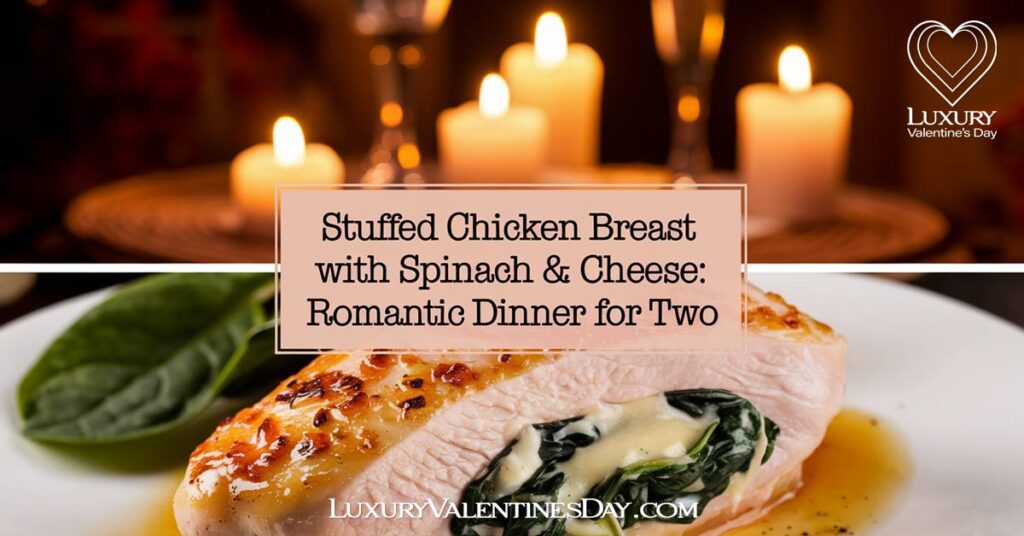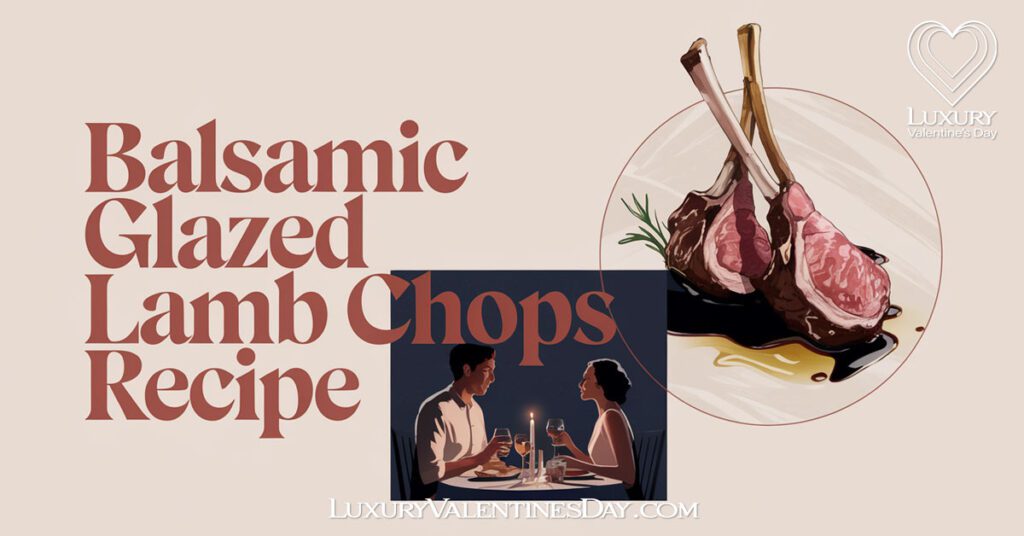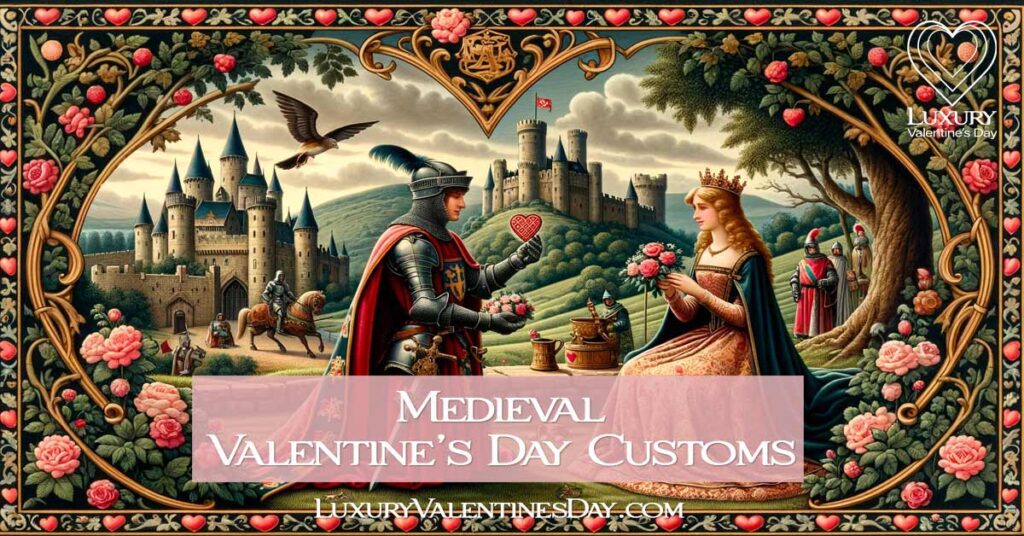
Table of Contents
ToggleEmbracing Love’s Timeless Tale: Medieval Valentine’s Day Customs
Step into a world where chivalry reigns and romance flourishes under the banner of medieval traditions. I’m your guide, a seasoned travel writer who has walked the cobblestone streets and explored ancient castles, uncovering the secrets of Valentine’s Day from an era long past. In this journey, we’ll unveil how the age of knights and troubadours shaped the way we celebrate love today. Get ready to be enchanted by tales of courtly love and age-old customs that continue to whisper through our modern Valentine’s celebrations.
Key Takeaways:
- Dive into the Past: Understand the origins and evolution of Valentine’s Day traditions, from their medieval roots to their contemporary significance. Discover how these age-old practices have influenced our modern-day celebration of love.
- Romance Redefined: Explore the unique and often romantic customs of medieval Valentine’s Day. From chivalrous acts to poetic exchanges, learn how love was celebrated in an era known for its distinct approach to romance.
- Literary Legacy: Delve into the rich tapestry of medieval literature and folklore, and see how it shaped the concept of love and Valentine’s Day celebrations in the Middle Ages. Discover the timeless stories and poems that continue to inspire lovers today.
A Brief History of Valentine’s Day Before the Middle Ages
Tracing Love’s Ancient Roots: From Pagan Rituals to Christian Saints

Before we journey through the medieval era, let’s wind back the clock to the very roots of Valentine’s Day. My travels and research have revealed a fascinating blend of ancient customs and evolving traditions.
Picture this: Ancient Rome, where the seeds of Valentine’s Day were first sown. The festival of Lupercalia, celebrated in mid-February, was a time of fertility rites and pairing rituals. But as the Roman Empire embraced Christianity, these pagan customs began to intertwine with the stories of Christian martyrs named Valentine.
One tale speaks of a priest (learn about saint valentine history) who defied Emperor Claudius II by secretly marrying couples to spare husbands from war. It’s in these acts of defiance and expressions of love that Valentine’s Day began to take shape. As Europe transitioned into the Middle Ages, these early traditions would pave the way for the romantic customs we associate with the period.
This historical tapestry, rich with change and continuity, sets the stage for the medieval Valentine’s Day we’re about to explore. It’s a story of evolution, where ancient rites meet chivalrous love, creating a legacy that endures in our modern celebrations of love.
Click here to learn more about the history of Valentine’s Day.
Transition to the Middle Ages: How Early Customs Influenced Medieval Celebrations
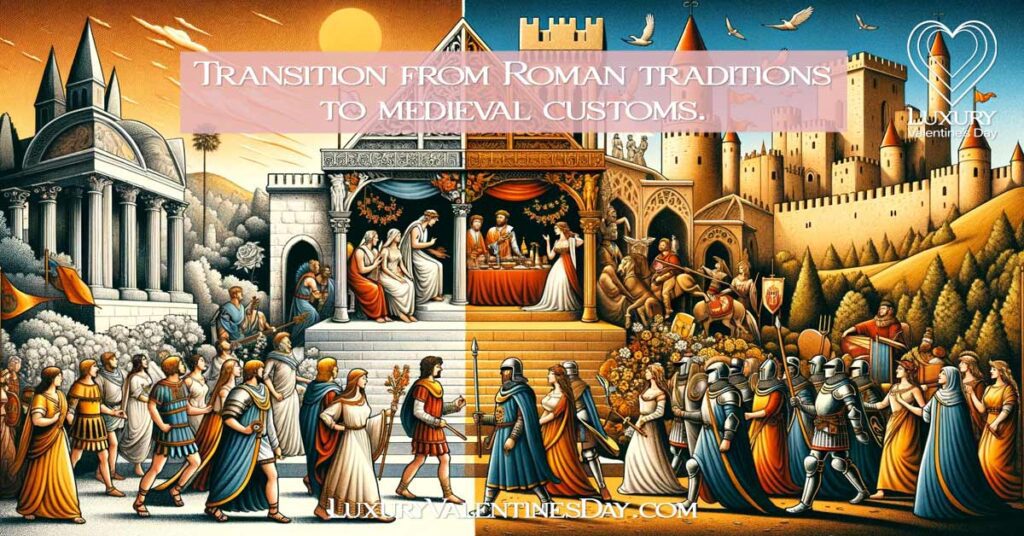
From Ancient Rituals to Chivalrous Rites: The Dawn of Medieval Romance
Imagine the transformation as we move from ancient Rome’s robust festivals to the more refined courts of the Middle Ages. This shift wasn’t sudden; it was a gradual blending of old and new, pagan and Christian, public and personal. As Europe transitioned into the Middle Ages, the seeds planted by ancient festivals like Lupercalia began to intertwine with Christian ideals of love and devotion. The tales of martyred saints named Valentine, known for their acts of love and kindness, found a new audience in a world increasingly fascinated by chivalry and courtly love.
During this time, love was no longer just a private emotion but a public spectacle, often entwined with the ideals of bravery and honor. The emergence of the concept of ‘courtly love’ transformed how love was expressed and celebrated. This was a time when gallant knights expressed their devotion through brave deeds and poetic words, setting the stage for the Valentine’s Day traditions we recognize in the medieval period.
As I’ve walked through the remains of medieval castles and read the aged manuscripts, I’ve seen how these early customs laid the groundwork for the romantic traditions of the Middle Ages. The personal exchange of love tokens, the composition of love songs and poems, and the celebration of Valentine’s Day as a day for lovers – all these practices have roots in the transition from ancient customs to medieval norms. It’s a fascinating journey through history, where each step tells a story of love’s enduring power to adapt and thrive in changing times.
If you want to discover the truth about valentine’s day and its dark secrets, just click the link!
Medieval Valentine’s Day Customs
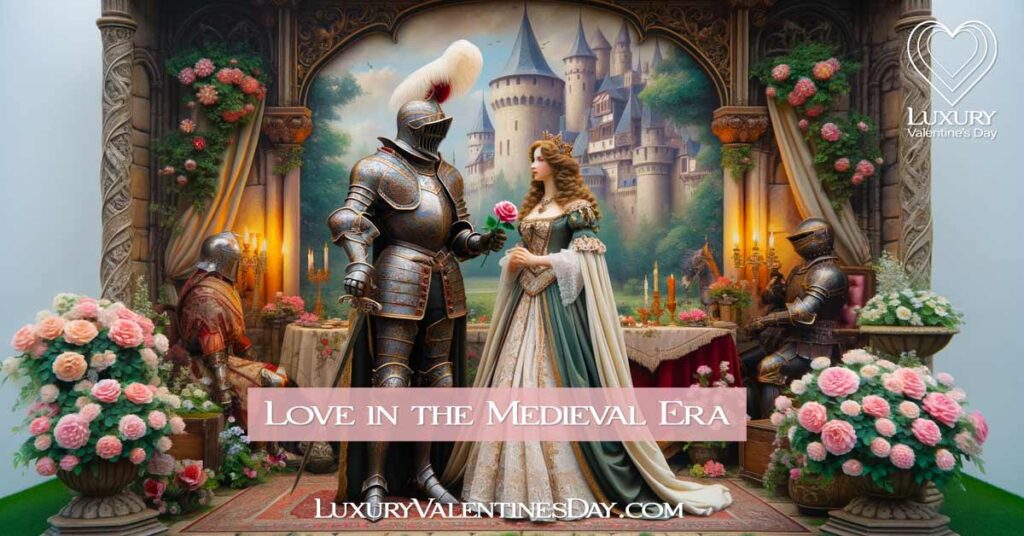
The Heart of Chivalry: Love in the Medieval Era
As we step into the heart of the Middle Ages, a period renowned for its distinct and romantic customs, we uncover the essence of Valentine’s Day as it was celebrated centuries ago. Here, in a world illuminated by torchlight and rich with the sounds of minstrels, the customs of love took on a form that has echoed down through the ages. From the grand halls of castles to the quiet corners of countryside villages, these traditions were more than mere rituals; they were the expressions of a culture deeply enamored with the ideals of chivalry and romance. Let’s embark on a journey back in time to discover the enchanting ways in which medieval lovers celebrated Valentine’s Day, a celebration that has left a lasting legacy on how we express love today.
Courtly Love and Chivalry: How Knights and Noblewomen Expressed Their Love
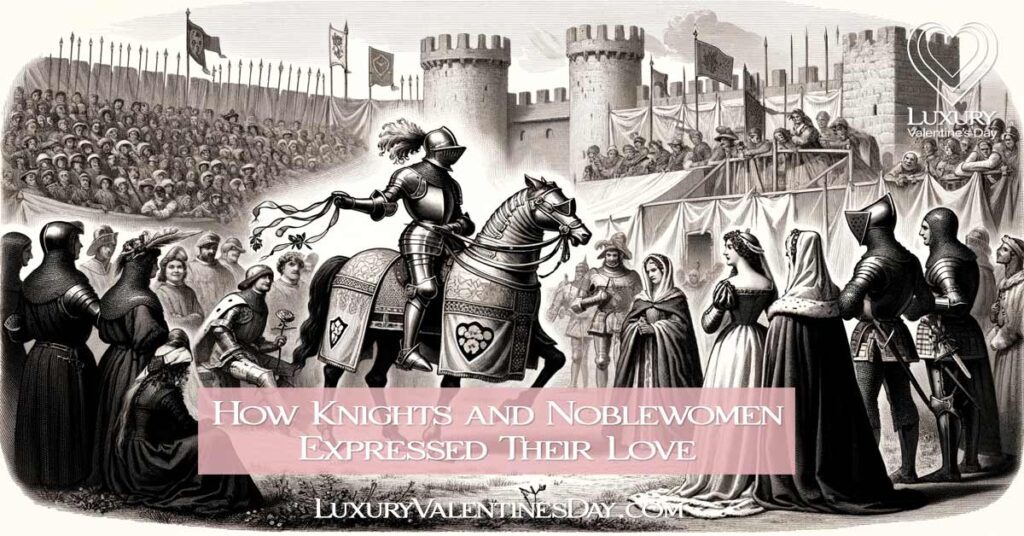
In the tapestry of medieval romance, courtly love stood as a shining ideal. This tradition, more a poetic construct than a reflection of everyday life, was defined by the noble knight’s adoration for a lady, often unattainable and of higher social standing. The knights, bound by chivalric codes, expressed their devotion not through direct courtship, but through acts of bravery, poetry, and enduring loyalty. This love was unrequited, platonic, yet imbued with deep passion and respect.
The practice of courtly love was encapsulated in the rituals and symbolic acts of the era. Knights bore the colors or tokens of their lady during tournaments, symbolizing their devotion. They penned verses and songs extolling their lady’s virtues, often performed in the courts as a testament to their enduring affection. These expressions of love, though steeped in idealism, reflected the complex interplay of social hierarchy, personal emotion, and the lofty ideals of chivalry.
A quintessential example of courtly love, though mythical, is the story of Sir Lancelot and Queen Guinevere from the Arthurian legends [1]. Their tale, a blend of myth and romanticized chivalry, captures the essence of this tradition. Lancelot, as one of King Arthur’s knights, falls deeply in love with Guinevere, the queen. Their story is marked by Lancelot’s acts of valour and devotion, undertaken in Guinevere’s name. Though their love was fraught with challenges and ultimately led to tragedy, it exemplifies the nature of courtly love – a complex mixture of loyalty, honor, and unattainable desire.
This medieval conception of love, with its emphasis on nobility, respect, and the elevating power of affection, has left an indelible mark on our contemporary ideas of romance. While the customs have evolved, the core ideals of courtly love – devotion, honor, and the celebration of the beloved – continue to resonate, especially in the context of modern Valentine’s Day celebrations.
The tradition of exchanging handmade love tokens during the medieval period offers a fascinating glimpse into the personal and intimate aspects of courtship and affection. This custom was not just about the gifts themselves, but also about the thought, creativity, and personal touch that went into making them, making them deeply meaningful and cherished.
The Art of Creating Love Tokens
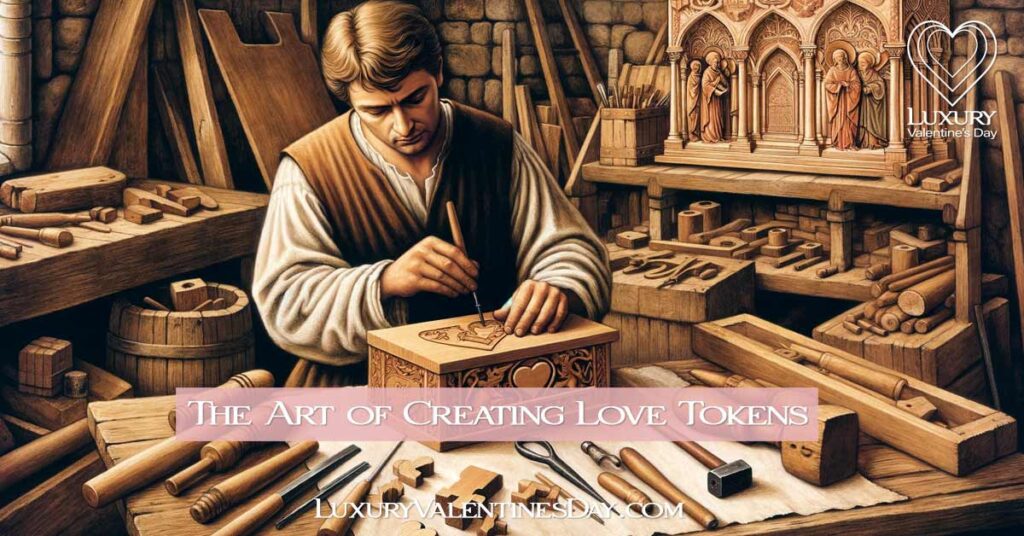
In medieval times, creating and giving love tokens was a way to express affection and devotion. These tokens [2] were often handcrafted, imbued with symbolism, and personalized to the recipient, reflecting the giver’s skills, resources, and feelings.
Examples of Medieval Love Tokens:
- Embroidered Items: Embroidery was a popular way for ladies to create love tokens. They would embroider symbols of love, such as hearts or love knots, onto handkerchiefs, banners, or even pieces of armor. The act of embroidery was seen as a sign of patience and devotion, making these items highly valued.
- Poetry Scrolls: Written word was a powerful medium for expressing love. Individuals would pen their own verses or quotes from popular love poems and enclose them in intricately decorated scrolls. These scrolls were sometimes adorned with ribbons or seals to make them more personal.
- Lockets and Rings: Small lockets, often containing a lock of hair or a miniature portrait, were exchanged as tokens of love. Similarly, rings engraved with romantic symbols or inscribed with love messages were popular gifts. These items were worn close to the body, symbolizing the constant presence of the lover.
- Carved Wooden Items: Wood carving was a skill many men possessed, and they would create intricate boxes, combs, or even sculptures as love tokens. These items were often decorated with symbols of love and courtship and were treasured as personal and thoughtful gifts.
- Love Knots: A simpler but no less meaningful token was the love knot, made of ribbon or cord. The complexity of the knot could symbolize the strength and intricacy of the giver’s feelings. These were often kept as cherished mementos.
Significance in Valentine’s Day Celebrations:
The tradition of giving handmade love tokens aligns closely with the modern spirit of Valentine’s Day, which emphasizes personal and heartfelt expressions of love. These medieval customs highlight the timeless human desire to express affection in unique and personal ways, a practice that continues to be a central part of Valentine’s Day celebrations. The artistry and sentiment behind these tokens remind us that, sometimes, the most cherished gifts are those that come from the heart and the hands.
Valentine’s Day Poems and Songs: The Rise of Romantic Poetry and Ballads
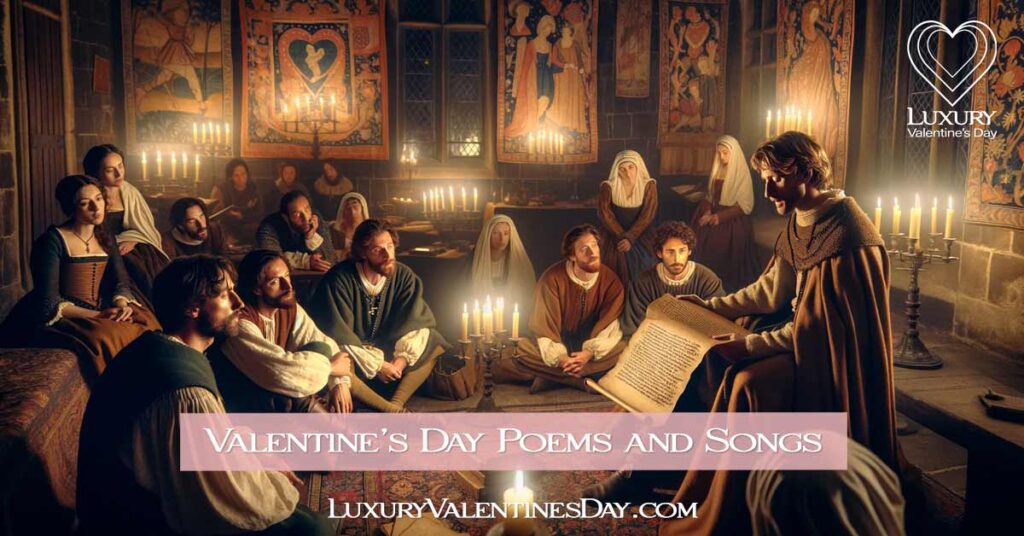
The medieval era witnessed the flowering of romantic poetry and ballads, becoming a hallmark of Valentine’s Day celebrations. In this age, poets and troubadours were akin to the celebrities of their time, their words weaving enchanting tales of love and chivalry. These creations weren’t just mere entertainment; they were expressions of the heart, often reflecting the complex emotions and social norms of love and courtship.
Valentine’s Day provided a perfect stage for the performance of these works. Poems and songs told stories of longing, devotion, and sometimes unattainable love, resonating deeply with their audiences. They often featured idealized and sometimes unrequited love, echoing the principles of courtly love that dominated the era.
Here’s a list of notable medieval poets and their works related to love:
Geoffrey Chaucer

Often considered the father of English literature, Chaucer’s “The Parliament of Fowls” is believed to be one of the first references linking Valentine’s Day with romantic love. In this poem, birds choose their mates on Valentine’s Day, an allegory reflecting the complexities of love and courtship.
“The Parliament of Fowls” by Geoffrey Chaucer [3], written in the late 14th century, is an allegorical poem that is often linked to the modern celebration of Valentine’s Day due to its themes of love and choosing mates. The poem is a dream vision, a popular genre in medieval literature, and is notable for its humorous and insightful portrayal of the complexities of romantic attraction and courtship.
“The Parliament of Fowls” [4] is very long, so I have written a summary of the poem:
- The Dream Vision: The poem begins with the narrator falling asleep and experiencing a dream. In the dream, he is led by Scipio Africanus, a historical figure, through the celestial spheres to a beautiful, walled garden, symbolizing both love and paradise.
- The Garden of Love: Inside the garden, the narrator encounters various figures representing different aspects of love, including allegorical figures like Venus, the goddess of love, and Cupid, her son. The garden is a place of both natural beauty and symbolic meaning, filled with birds and other figures.
- The Parliament of Birds: The central event of the poem is a gathering of birds on Valentine’s Day to choose their mates. This assembly, or parliament, is presided over by the goddess Nature. Each bird represents a different social class and attitude towards love, from the noble eagles to the lower-ranking birds.
- The Debate on Love: The birds engage in a debate about love and the choosing of mates. Three male eagles compete for the affection of a female eagle, each presenting their case. The other birds, each with their own perspective on love, comment and argue about the situation.
- Nature’s Decision: The poem concludes without a clear resolution to the love debate among the eagles. Nature, overseeing the parliament, decrees that the female eagle should have the freedom to choose her mate in her own time. This decision is seen as a celebration of free will in matters of love.
- The Dream Ends: The narrator wakes from the dream, leaving the story open-ended and the debate on love unresolved.
“The Parliament of Fowls” is celebrated for its innovative use of the dream vision to explore themes of love and social hierarchy. Chaucer’s use of humor and keen observation of human nature make it a valuable and entertaining insight into medieval perspectives on love and courtship. The poem’s connection to Valentine’s Day lies in its setting on this day, linking the tradition of choosing mates with the celebration of love.
Dante Alighieri

Although more famous for “The Divine Comedy,” Dante’s “La Vita Nuova” is a profound expression of courtly love, detailing his love for Beatrice, which was both idealized and spiritual in nature.
“La Vita Nuova” (The New Life) is a prosimetrum, a combination of prose and verse, written by Dante Alighieri [5]. It’s a unique piece, combining poetry with a narrative and analysis, revolving around Dante’s love for Beatrice, which is both idealized and spiritual. The work is pivotal in medieval literature for its exploration of courtly love. Here are some of the most relevant and poignant excerpts:
- The First Encounter: Dante describes his first meeting with Beatrice when both were children. He writes about being immediately struck by her beauty and virtue, marking the beginning of his lifelong love and admiration for her.
- Beatrice’s Influence: Throughout “La Vita Nuova,” Dante details how Beatrice’s presence inspires him to seek spiritual and moral elevation. Her influence is portrayed as transformative, leading Dante towards a new understanding of love and life.
- Love and Suffering: Dante’s poems often reflect the pain of unrequited love and the longing he feels for Beatrice, who remains a distant and almost ethereal figure in his life. His verses convey the intensity of his emotions and the torment of loving someone he cannot be with.
- Vision of Beatrice: In one of the most famous scenes, Dante describes a vision in which Love (personified) appears to him and shows him a sleeping Beatrice. Love says, “I am your master,” indicating the profound impact Beatrice has on Dante’s life and writings.
- Beatrice’s Death: The latter part of “La Vita Nuova” deals with Beatrice’s death, which deeply affects Dante. He writes about his grief and the realization that his love for her must now be spiritual, as she has moved beyond the earthly realm.
- The Final Sonnet: The work concludes with a sonnet in which Dante vows to write no more of Beatrice until he can do so in a manner befitting her, hinting at the divine journey he would later undertake in “The Divine Comedy.”
“La Vita Nuova” [6] is significant for its exploration of courtly love and its influence on the Italian and broader European literary tradition. Dante’s portrayal of his love for Beatrice set a new standard for the poetic expression of love and devotion.
Christine de Pizan
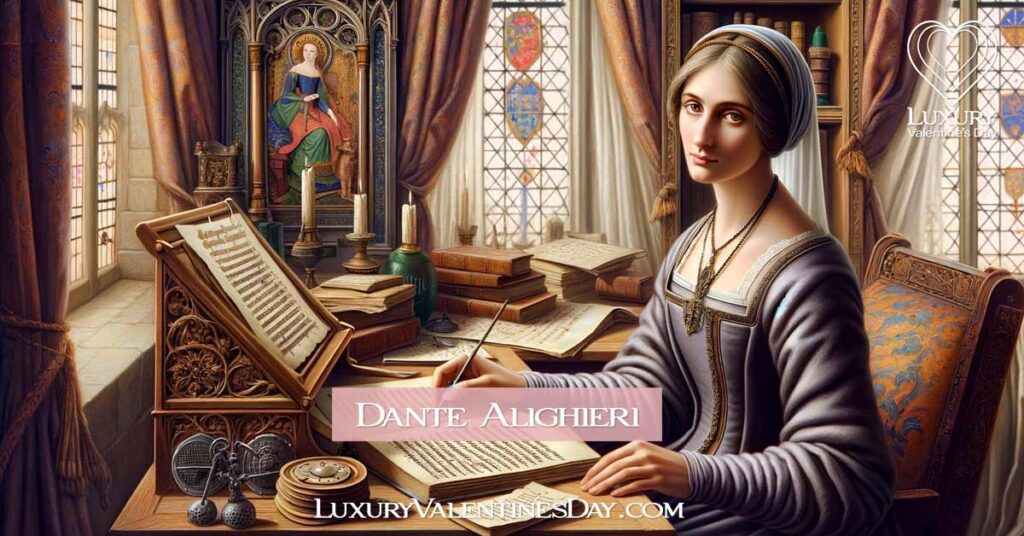
A unique voice in medieval literature, Christine’s works often centered on themes of love and chivalry from a female perspective. Her collection of ballads and rondeaux, written in the late 14th and early 15th centuries, provided a nuanced view of love and relationships.
Christine de Pizan [7], a notable figure in medieval literature, was one of the first women to earn a living as a writer. Her works often focused on themes of love, courtly behavior, and the role of women in society. Here’s an example of her work that reflects her views on love:
Excerpt from “The Book of the City of Ladies”: One of her most famous works, “The Book of the City of Ladies,” is not a traditional love poem but a defense of women and their capabilities. In it, Christine constructs an allegorical city where women are appreciated and respected for their virtues and accomplishments. This work is significant for its portrayal of women and its challenge to the misogynistic attitudes of the time.
Example of a Ballad: While “The Book of the City of Ladies” [8] is more focused on societal themes, Christine de Pizan also wrote many poems and ballads that dealt with love in a more traditional sense. One example is a ballad where she writes:
“Sweet and gracious figure so dear and merciful,
When I see you, a joyousness of great marvel fills me.
Nothing else can comfort my heart so much;
I am yours since it pleases you, my very sweet love.”
This ballad reflects the style of courtly love prevalent in her time, characterized by a deep sense of respect and devotion. The language is filled with admiration and reverence, typical of the courtly love tradition.
Christine de Pizan’s works stand out in medieval literature for their eloquent portrayal of love and their pioneering feminist perspective. Her poetry and prose provided a unique voice in a time dominated by male writers, offering a fresh take on traditional themes of love and chivalry.
Charles, Duke of Orléans
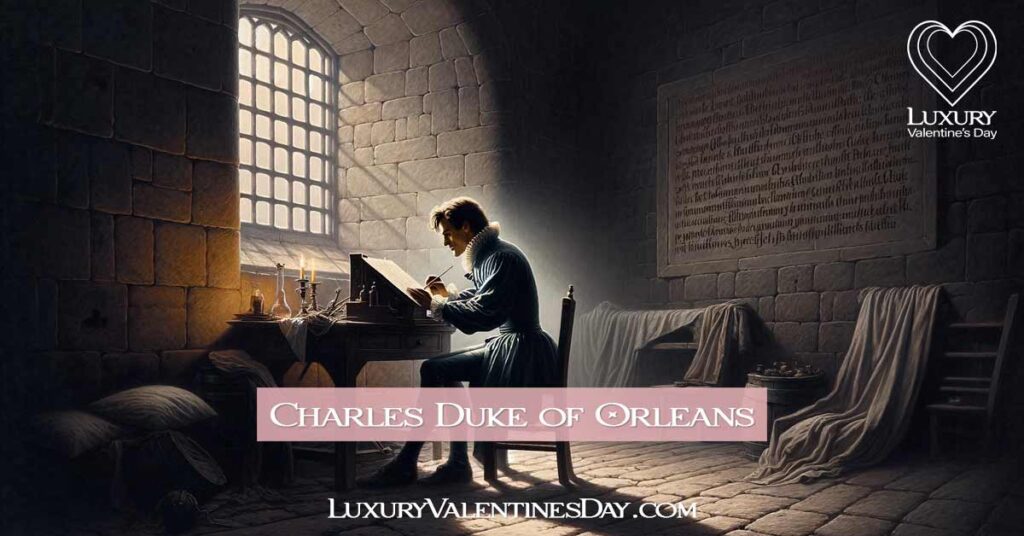
Charles, Duke of Orléans [9], is a significant figure in the history of Valentine’s Day due to his contribution to the early tradition of sending love poems on this occasion. His life was marked by both political turmoil and deep personal loss, which greatly influenced his poetic works.
One of his earliest known Valentine’s poems to his wife while imprisoned in the Tower of London. His works often reflect the longing and emotional depth of separated lovers.
Background: Charles was captured at the Battle of Agincourt in 1415 and spent twenty-five years as a prisoner in England, much of it in the Tower of London. It was during this long captivity that he penned some of his most memorable poetry, expressing his feelings of longing and separation.
Valentine’s Day Poem to His Wife: One of his most notable contributions is what’s considered one of the earliest known Valentine’s poems, written to his wife. The poem reflects his deep longing and love for her, despite being physically separated by his imprisonment. An excerpt from this poem goes:
“I am already sick of love, My very gentle Valentine.”
This verse encapsulates the longing and emotional depth characteristic of Charles’s poetry, reflecting the sentiments of a lover separated from his beloved, a theme that resonates with many even today.
Emotional Depth in His Poems: Charles’s work often delved into themes of separation, longing, and the bittersweet nature of love. Another example of his poetry showcases this:
“Alone, lamenting in great distress, Thinking of my great unhappiness, Wishing for death continually, That I might escape this misery.”
These lines convey the depth of his emotional turmoil and the intensity of his feelings, a hallmark of his poetry.
Relevance to Valentine’s Day Celebrations: The works of Charles, Duke of Orléans, hold a special place in the history of Valentine’s Day. His practice of penning love poems, especially under the circumstances of separation and longing, resonates with the essence of Valentine’s Day – a time to express deep, often unspoken feelings of love. His contributions echo through time, influencing how we view and celebrate love and Valentine’s Day, particularly in the context of enduring love in the face of adversity.
Guillaume de Machaut
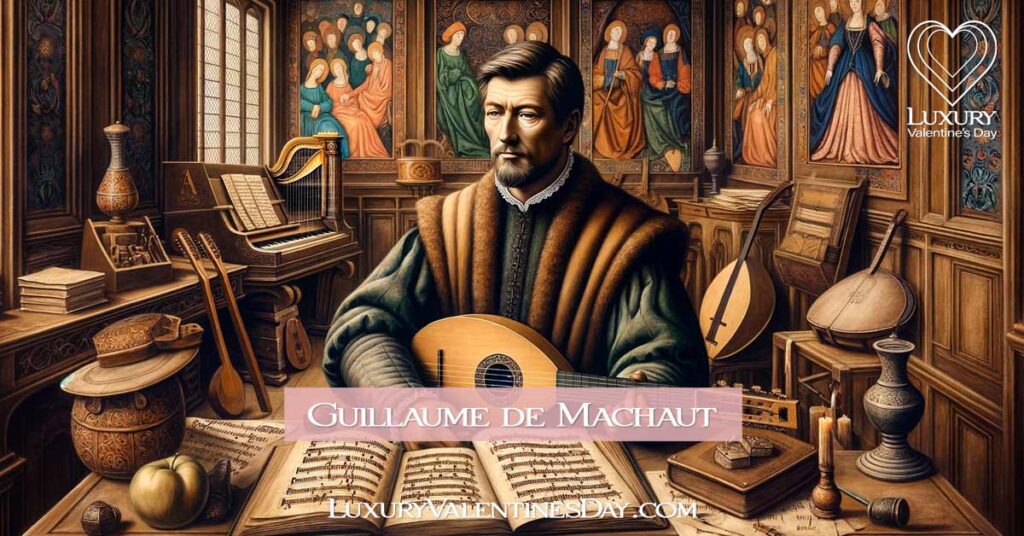
Guillaume de Machaut [10], a towering figure in the medieval era, was a French poet and composer whose work left a lasting impact on the way love is expressed in poetry and music. His contributions are particularly relevant to the celebration of Valentine’s Day, as they encapsulate the full spectrum of romantic experience – from the joyous heights of love to its more sorrowful aspects.
Life and Influence:
Machaut lived during the 14th century, a period marked by significant social and cultural changes. As both a cleric and an artist, his work bridges the sacred and the secular. He was at the forefront of developing the style of music known as the Ars Nova, which brought more complexity and emotional depth to medieval music.
Love’s Joys and Sorrows in Poetry:
Machaut’s poetry, often set to his own music, delves into the themes of love, reflecting the courtly love tradition of his time. His verses speak of the joys of new love, the pain of unrequited feelings, and the sorrow of love lost.
One of his most famous compositions is the “Le Messe de Nostre Dame,” a groundbreaking work in the history of music. While it is primarily a religious piece, the emotional depth and complexity of the music speak to the broader themes of longing and devotion, which are central to the experience of love.
Example of His Work:
In his lyric poetry, Machaut often explores the nuanced emotions of love. One of his ballades, “Douce Dame Jolie,” for instance, is a plea from a lover to his beloved, expressing both the sweetness and the pain of love:
“Douce dame jolie, Pour Dieu, ne pensez mie Que nulle ait signorie Seur moy fors vous seulement.”
Translated, this reads:
“Sweet lovely lady, For God’s sake, do not think That anyone has control Over me but you alone.”
This ballade perfectly encapsulates the ideal of courtly love – a mix of reverence, longing, and a sense of devotion to an almost unattainable beloved.
Relevance to Valentine’s Day:
Machaut’s works resonate with the themes of Valentine’s Day, as they express the myriad emotions associated with love. His ability to capture both the joy and the sorrow of love in his poetry and music makes his work particularly relevant to this day of romantic celebration. His legacy is a reminder that love, in all its forms, has always been at the heart of human expression, and his poems and songs continue to inspire those who seek to articulate their deepest feelings of love and affection.
These poets and their works provide a fascinating window into how love was conceptualized and celebrated in the medieval period. Their legacy continues to inspire and inform our understanding of romantic expression, adding a historical richness to the way we celebrate love, especially on Valentine’s Day.
Famous Medieval Love Stories
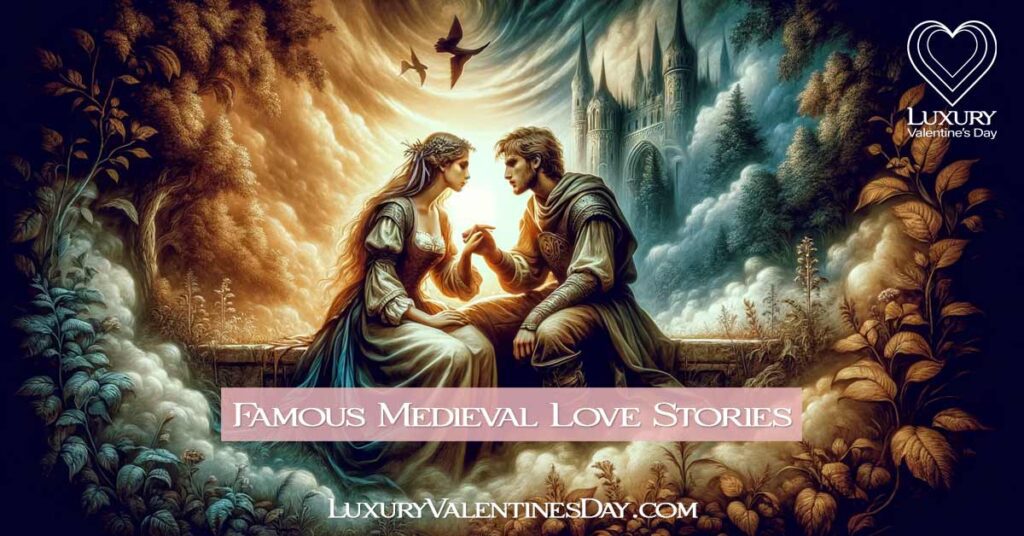
In the realm of medieval romance, love stories were not just tales; they were epic sagas that captured the complexities of the heart. These narratives, woven into the fabric of medieval literature, bring to life the passion, tragedy, and enduring nature of love. From knights and princesses to poets and philosophers, these stories traverse the spectrum of love in all its forms – unrequited, forbidden, passionate, and tragic.
As we delve into some of the most famous medieval love stories, we find tales that have transcended time, continuing to inspire and move us to this day. Each story offers a unique glimpse into the medieval perspective on love, reflecting the cultural and societal norms of the era, and adding a rich historical layer to our modern understanding of romance.
Certainly! Expanding on “Famous Medieval Love Stories” beyond Lancelot and Guinevere, there are several other tales from the medieval era that have captivated audiences with their romantic and often tragic narratives.
Tristan and Isolde
One of the most iconic love stories of the medieval period is that of Tristan and Isolde [11]. Originating from Arthurian romance and Celtic legend, this tale revolves around the tragic love story of Tristan, a knight of King Mark of Cornwall, and Isolde, an Irish princess. Their love, ignited by a potion, is both passionate and forbidden, leading to a series of dramatic and heartrending events. This story has been a source of inspiration for numerous works in Western literature and music.
Abelard and Heloise
The story of Abelard and Heloise [12] is renowned not only for its romantic intensity but also for its basis in real historical figures. Peter Abelard, a medieval philosopher, and Heloise, his student, fell deeply in love, leading to a secret marriage and a child. Their relationship faced severe challenges, including a tragic end for Abelard and Heloise being forced into a convent. Their passionate letters have survived, offering a window into their intense and intellectual bond.
Paolo and Francesca
Dante’s “Divine Comedy” introduces us to Paolo and Francesca, two lovers condemned to the second circle of hell for their adulterous affair. Francesca, married to Paolo’s brother, falls in love with Paolo, leading to their tragic demise. Their story is a poignant exploration of love, guilt, and the consequences of their forbidden relationship.
The Story of Troilus and Criseyde
Chaucer’s “Troilus and Criseyde” is a tale of love and betrayal set during the Trojan War. Troilus, a Trojan prince, falls in love with Criseyde, only to be betrayed when she leaves him for the Greek warrior Diomedes. This narrative, full of passion and sorrow, explores themes of loyalty, fate, and the fickle nature of fortune.
These stories, with their blend of passion, tragedy, and sometimes moral complexity, reflect the medieval conception of love as a powerful, often uncontrollable force. They continue to resonate in modern culture, reminding us of the timeless nature of love and the human experiences surrounding it. These narratives add depth to our understanding of historical perspectives on love and enrich the celebration of Valentine’s Day with a sense of continuity and tradition.
The Influence of Medieval Literature on Valentine’s Day
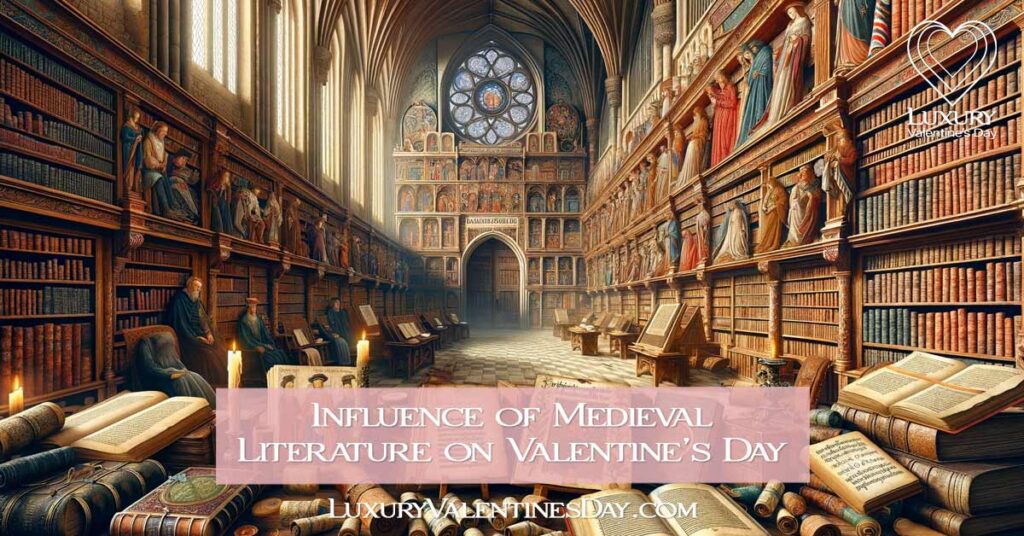
As we turn the pages back to medieval literature, we uncover a treasure trove of romantic ideals and narratives that have significantly shaped the way we celebrate Valentine’s Day. This era, renowned for its courtly love and chivalric tales, has left an enduring imprint on modern romantic traditions.
From the intricate courtship rituals in chivalric tales to the profound expressions of love in poetry, medieval literature has woven a rich tapestry of influence that continues to color our contemporary understanding and celebration of love.
Here I explore how the timeless themes and legendary love stories from medieval literature have contributed to the symbols, customs, and emotional resonance of Valentine’s Day, enriching it with historical depth and cultural significance.
The influence of medieval literature on Valentine’s Day is profound and multifaceted, shaping the way we understand and celebrate love in the contemporary world. This literature, rich in romantic ideals and expressions, has left an indelible mark on the cultural and emotional landscape of Valentine’s Day.
The Romantic Ideals of Courtly Love
Medieval literature introduced and popularized the concept of courtly love, a form of romantic expression that emphasized chivalry, respect, and admiration from a distance. This idealized form of love, often expressed through poetry and song, laid the foundation for modern romantic gestures. The elaborate rituals of courtship and the emphasis on emotional, often unrequited love in these stories, resonate with the way we express affection on Valentine’s Day.
The Role of Chivalry and Noble Deeds
The chivalric codes and noble deeds depicted in medieval literature have influenced the expectations and expressions of romance. The idea of a knight performing brave acts in the name of love has evolved into modern gestures of grandeur and thoughtfulness on Valentine’s Day. The tradition of giving gifts, planning special experiences, and even the simple act of writing heartfelt messages can be traced back to these medieval customs.
Literary Examples and Their Influence
- Geoffrey Chaucer’s “The Parliament of Fowls”: Often cited as one of the first connections between romantic love and Valentine’s Day, Chaucer’s poem has played a significant role in linking the day with the celebration of love.
- Arthurian Legends: Tales of King Arthur and his knights, particularly the story of Lancelot and Guinevere, have romanticized the idea of passionate, if sometimes tragic, love. These tales have shaped the perception of Valentine’s Day as a time to celebrate intense and enduring love.
- Dante’s “La Vita Nuova”: This work, celebrating Dante’s love for Beatrice, showcases the spiritual and transcendent nature of love, influencing the way love is celebrated as not just a physical or emotional experience but also a spiritual journey.
Enduring Themes and their Modern Resonance
The themes of love, sacrifice, and the pursuit of an ideal in medieval literature have given Valentine’s Day a depth beyond mere commercial celebration. They remind us that love, in its many forms, is a fundamental and enduring human experience. The stories and characters from medieval literature continue to inspire modern lovers, offering timeless lessons on the nature of love and the ways it can be expressed and celebrated.
In conclusion, the influence of medieval literature on Valentine’s Day is significant. It has not only contributed to the romantic customs we observe but also enriched the day with historical and cultural depth, making it a celebration that transcends time and continues to evolve with each generation.
My Final Thoughts: Echoes of Medieval Romance in Modern Love
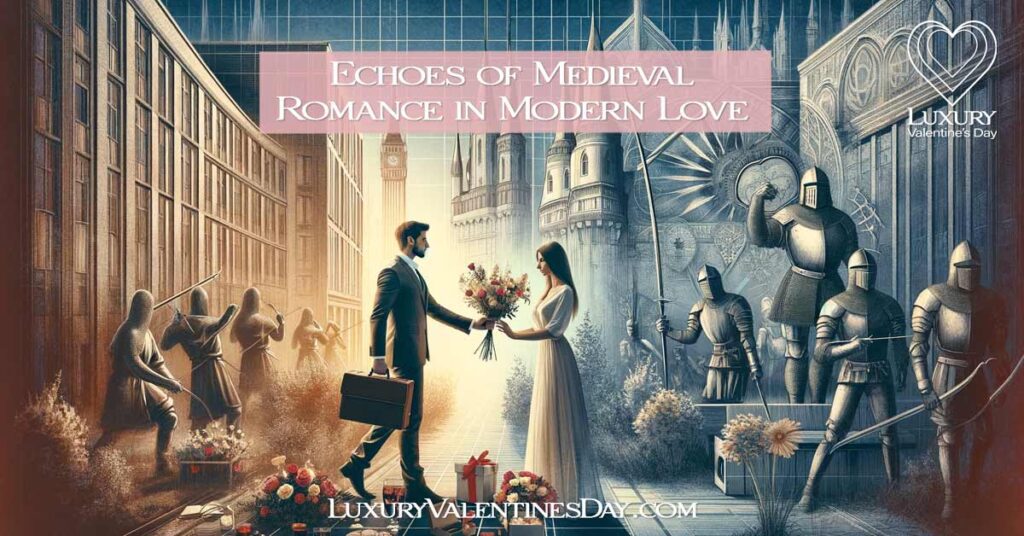
As I conclude our journey through the medieval Valentine’s Day customs and literature, we find ourselves at the crossroads of past and present. This exploration has unveiled a rich tapestry of traditions and ideals from an era long gone, yet these echoes of medieval romance still resonate profoundly in our modern celebrations of love.
Unveiling the Heart of Medieval Romance: Frequently Asked Questions
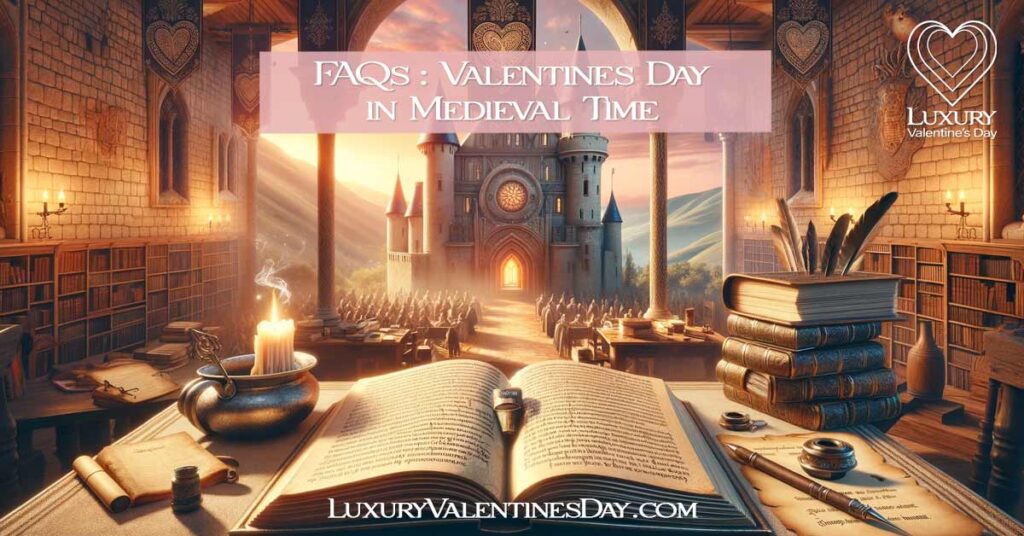
How was Valentine’s Day celebrated in medieval times?
In medieval times, Valentine’s Day was celebrated with a blend of courtly love traditions and various local customs. It often involved romantic gestures like writing love poems, singing ballads, and exchanging handmade tokens of affection. Knights would express their admiration for ladies through chivalric deeds and poetic expressions. In some areas, Valentine’s Day was marked by festivals where young people would participate in matchmaking games and dances.
What would girls do on Valentine’s Day in medieval times?
Girls in medieval times would engage in several Valentine’s Day customs. They might receive poems or songs written in their honor by admirers, reflecting the era’s emphasis on courtly love. In some traditions, girls would participate in matchmaking lotteries, where they would be paired with a male partner for the day’s festivities. It was also common for girls to create and give handmade tokens of affection, such as embroidered handkerchiefs or love knots, to express their feelings.
Were there any specific Valentine’s Day traditions unique to the medieval period?
Yes, several Valentine’s Day traditions were unique to the medieval period. One such tradition was the practice of “drawing lots” where young people would draw names to determine their Valentine for the celebrations. Another was the custom of knights wearing a lady’s token, such as a ribbon or scarf, during tournaments as a sign of affection and devotion. These practices highlighted the social and romantic customs of the era.
What was medieval love like?
Medieval love, particularly as depicted in literature and the arts, was often characterized by the ideals of courtly love. This concept, which emerged in the noble courts of Europe, depicted love as a noble, almost spiritual pursuit, marked by chivalry, respect, and a sense of adoration from afar. It was not always based on personal intimacy but rather on admiration and devotion to an idealized figure. Romantic love in the medieval era also had an element of drama and tragedy, as seen in many of its legendary stories. In everyday life, while marriages were often arranged for political or economic reasons, there is evidence through letters and personal diaries that romantic love, as we understand it today, did exist and was cherished.
Referrence
[1] “Lancelot and Guinevere: The Love Affair through the Ages” by Kimberly Ellis, 12 December 2000 : https://vault.hanover.edu/~battles/arthur/affair
[2] “Five Medieval Love Tokens” by By Danièle Cybulskie : https://www.medievalists.net/2016/02/five-medieval-love-tokens/
[3] Geoffrey Chaucer, from Westminster Abbey : https://www.westminster-abbey.org/abbey-commemorations/commemorations/geoffrey-chaucer
[4] Geoffrey Chaucer : “The Parliament of Fowls” Translated by A. S. Kline : https://www.poetryintranslation.com/PITBR/English/Fowls.php
[5] Dante Alighieri by Mark Cartwright. World History Encyclopedia : https://www.worldhistory.org/Dante_Alighieri/
[6] “La Vita Nuova” by Dante Alighieri, Translated by A. S. Kline on Poetry in Translation : https://www.poetryintranslation.com/PITBR/Italian/TheNewLifeI.php
[7] Christine de Pizan: Her Works By Student Deanna Rodriguez, on A Medieval Woman’s Companion : https://amedievalwomanscompanion.com/christine-de-pizan/
[8] “The Book of the City of Ladies” by Christine de Pizan at the Library of Congress : https://www.loc.gov/item/2021667679/
[9] Charles, Duke of Orléans, by Eleanor Jackson at the British Library : https://blogs.bl.uk/digitisedmanuscripts/2021/02/charles-dorl%C3%A9ans.html
[10] Guillaume de Machaut by Pierre-F. Roberge (discography) and Todd M. McComb (texts) on Medieval Music & Arts Foundation : http://www.medieval.org/emfaq/composers/machaut.html
[11] Tristan and Isolde, introduction by by Noel Wallace on Press Books : https://pressbooks.pub/earlybritishlit/chapter/tristan-and-ysolt/
[12] “A Medieval Love Story – Abelard and Heloise” by Michael Clanchy at Medieval Histories : https://www.medieval.eu/medieval-love-story-abelard-heloise/
Related Posts
- Date Ideas That Start with U: Unique and Unforgettable Dates
- Dating Quotes Cute Enough to Make Your Heart Flutter
- Butternut Squash Ravioli with Sage Butter: A Perfect Romantic Dinner for Two
- Alphabet Date Ideas: A to Z Guide for Creative Couples
- Valentine’s Day Bathroom Décor Ideas: Transform Your Space into a Romantic Haven
- Date Ideas That Start with J: Joyful and Jazzy Dates












